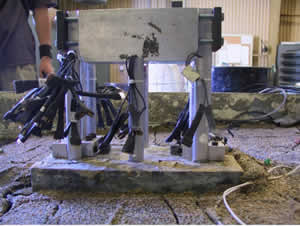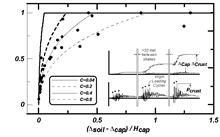| Project Title/ID Number |
Simulation of Soil-Foundation-Structure
Interaction of Deep Foundations—2312003 |
| Start/End Dates |
10/1/03—9/30/04 |
| Project Leader |
Ross Boulanger (UCD /F) |
| Team Members |
Scott Brandenberg (UCD/GS),
Dongdong Chang (UCD/GS), Heidi Feigenbaum (UCD/GS) |
F=faculty; GS=graduate student; US=undergraduate student; PD=post-doc; I=industrial
collaborator; O=other
Click on images to enlarge in a new window
1. Project Goals/Objectives:
The objectives of this project are:
-
To perform OpenSees-based simulations
of the seismic response of deep foundations in liquefied and laterally
spreading ground, using the nonlinear
p-y, t-z, and q-z material models developed and implemented in Year
6,
-
Use the OpenSees-based simulations and available experimental data
to investigate pressing issues in the development of performance-based
pseudo-static
pushover design methodologies, and
-
Evaluate emerging pushover design
methodologies against available physical data in support of the related
proposal for “Summary
Workshop on Emerging Design Methodologies for Pile Foundations in
Liquefied Ground.”
2.
Role of this project in supporting PEER’s mission
(vision):
This project supports PEER's mission of providing performance based
methodologies for bridge and building systems by addressing a problem
that is of strong interest to owners and a major source of uncertainty
in current design and assessment practices.
3. Methodology Employed:
The OpenSees-based simulations have focused on validation against existing
centrifuge model test data for pile foundations in laterally spreading
ground. Comparisons of simulations and experimental recordings have identified
important physical mechanisms that were subsequently explored further
by detailed back-analyses of loading mechanisms from the dense instrumentation
arrays in the centrifuge models by Boulanger et al. (2003) and Chang
et al. (2004). Attention is being focused on:
-
The lateral load transfer
mechanism between pile groups/caps and laterally spreading non-liquefied
crust layers,
-
The ability of pile foundations to restrain lateral
spreading of bridge abutments, which reduces the loads compared
to those predicted
by uncoupled
analyses of the lateral spreading and foundation responses;
and
-
Suitable kinematic and inertial load combinations for performance-based
design practice. The plan for the comparative evaluation
of emerging design methodologies is described in the accompanying
proposal for
a summary workshop.
4. Brief Description of past year’s accomplishments
(Year 6) & more detail on expected Year 7 accomplishments:
 This
project is the natural progression of the work performed in prior years
on developing and implementing p-y, t-z, and q-z materials for liquefaction
conditions into OpenSees and the subsequent validation efforts. These different
material models are now available on the OpenSees website and are being
used by other researchers. The models are described in a report (Boulanger
et al. 2003) and an upcoming ASCE-GI conference paper (Boulanger et al.
2004).
This
project is the natural progression of the work performed in prior years
on developing and implementing p-y, t-z, and q-z materials for liquefaction
conditions into OpenSees and the subsequent validation efforts. These different
material models are now available on the OpenSees website and are being
used by other researchers. The models are described in a report (Boulanger
et al. 2003) and an upcoming ASCE-GI conference paper (Boulanger et al.
2004).
Simulations of piles in lateral spreads led to a re-evaluation of
the load-transfer mechanism between pile caps and non-liquefied surface
crust layers. This
re-examination showed that the occurrence of liquefaction beneath a surface
layer caused the load-versus-relative-displacement relation to be much
softer than expected based on the common analogy to the static loading of
retaining
walls. This photo shows a side view of a centrifuge model pile cap embedded
in a clay layer, after a surface layer of dry sand has been removed, that
spread laterally over a loose sand layer that liquefied during earthquake
shaking. Notice the passive bulge on the uphill/right side of the cap,
the gap on the downhill/left side, and the various ground cracks.
 The lateral
load on the pile cap during virgin peak relative displacements were plotted
versus the relative displacement between the pile cap and
the free-field soil to the side of the pile cap (approximating the lateral
spreading
displacement that would occur away from the influence of the pile cap).
The resulting load-transfer relation, shown below, was an order of magnitude
softer than expected based on analogy to static load tests on retaining
walls (as represented by the C=0.04 line in this figure). These results
are presented in a paper at the upcoming WCEE conference by Brandenberg
et al. (2004).
The lateral
load on the pile cap during virgin peak relative displacements were plotted
versus the relative displacement between the pile cap and
the free-field soil to the side of the pile cap (approximating the lateral
spreading
displacement that would occur away from the influence of the pile cap).
The resulting load-transfer relation, shown below, was an order of magnitude
softer than expected based on analogy to static load tests on retaining
walls (as represented by the C=0.04 line in this figure). These results
are presented in a paper at the upcoming WCEE conference by Brandenberg
et al. (2004).
Simulations of the dynamic responses of the pile-group-supported
structures, like the one shown in the photograph above, are focusing on
the timing
of inertial and kinematic load combinations. Again, these comparisons
led to
some more advanced back-analysis efforts on the experimental data,
which involved superstructures with fixed-based periods of 0.3 and 0.8 seconds
and two very different earthquake ground motion records. These results
are showing that the peak lateral loading conditions occur mainly
during
strong
shaking and are very close (within 10%) to the sum of the peak kinematic
and peak inertial loads alone. Numerical analyses indicate that the
appropriate load combinations are dependent on the pile foundation's
lateral stiffness
and the period of the structure relative to the dominant period for
the laterally spreading crust as it transiently lurches during shaking.
Additional
analyses are progressing to numerically evaluate these findings over
a broader range of ground motions, soil conditions, structural periods,
and foundation
stiffness.
5. Other Similar Work Being Conducted Within and Outside
PEER and How This Project Differs:
Boulanger and Kutter have performed dynamic centrifuge model tests of
piles in liquefied and laterally spreading ground with Caltrans funding.
Dobry, Abdoun, and O’Rourke, in various collaborations, have also
been doing centrifuge studies and developing simplified design methods
(pseudo-static), but not nonlinear time-history methods. Ashford and colleagues
have been doing field tests of piles in soils liquefied by blasting and
have back-calculated p-y behavior. Elgamal, Dobry, & Abdoun are starting
additional physical modeling efforts (shake table and centrifuge) in collaboration
with Japanese researchers. To my knowledge, none of these other studies
are performing dynamic FEM analyses similar to those proposed herein or
are addressing the same design issues. The project proposed herein would
bring these researchers together in the comparative study and associated
workshop.
6. Plans for Year 8 if project is expected to be continued:
It is expected that completion of the above tasks will naturally progress
into year 8. The development of performance based design methodologies requires
addressing several different unresolved issues, of which only a few are
being addressed in year 7. In addition, it is anticipated that PEER lifelines
will fund additional centrifuge testing in years 8-10 that will address
the interaction between bridge abutments and pile foundations in the presence
of liquefaction. One issue being explored in these tests is the ability
of pile foundations to restrain lateral spreading of bridge abutments; thereby
reducing the loads compared to those predicted by uncoupled analyses of
the lateral spreading and foundation responses. OpenSees-based simulations
of those centrifuge models are needed to validate the ability of our numerical
methods to capture this form of soil-structure-interaction, and subsequently
explore a broader range of conditions than can be modeled in centrifuge
experiments.
In addition, a continuation of this project would include providing
numerical modeling and validation support to the PBEE demonstration projects
planned
under the Bridge and Transportation Systems area.
7. Describe any actual instances where you are aware your
results have been used in industry:
8. Expected Milestones & Deliverables:
The deliverables of this project will include:
-
A report documenting the
recommendations for performance-based design practice as derived
from the OpenSees-based simulations, the re-examination
of existing dynamic centrifuge model test data, and the comparative
evaluations of emerging design methodologies, and
-
Continuing revisions
and upgrades to the p-y, t-z, and q-z material models in OpenSees.
 This
project is the natural progression of the work performed in prior years
on developing and implementing p-y, t-z, and q-z materials for liquefaction
conditions into OpenSees and the subsequent validation efforts. These different
material models are now available on the OpenSees website and are being
used by other researchers. The models are described in a report (Boulanger
et al. 2003) and an upcoming ASCE-GI conference paper (Boulanger et al.
2004).
This
project is the natural progression of the work performed in prior years
on developing and implementing p-y, t-z, and q-z materials for liquefaction
conditions into OpenSees and the subsequent validation efforts. These different
material models are now available on the OpenSees website and are being
used by other researchers. The models are described in a report (Boulanger
et al. 2003) and an upcoming ASCE-GI conference paper (Boulanger et al.
2004). The lateral
load on the pile cap during virgin peak relative displacements were plotted
versus the relative displacement between the pile cap and
the free-field soil to the side of the pile cap (approximating the lateral
spreading
displacement that would occur away from the influence of the pile cap).
The resulting load-transfer relation, shown below, was an order of magnitude
softer than expected based on analogy to static load tests on retaining
walls (as represented by the C=0.04 line in this figure). These results
are presented in a paper at the upcoming WCEE conference by Brandenberg
et al. (2004).
The lateral
load on the pile cap during virgin peak relative displacements were plotted
versus the relative displacement between the pile cap and
the free-field soil to the side of the pile cap (approximating the lateral
spreading
displacement that would occur away from the influence of the pile cap).
The resulting load-transfer relation, shown below, was an order of magnitude
softer than expected based on analogy to static load tests on retaining
walls (as represented by the C=0.04 line in this figure). These results
are presented in a paper at the upcoming WCEE conference by Brandenberg
et al. (2004).